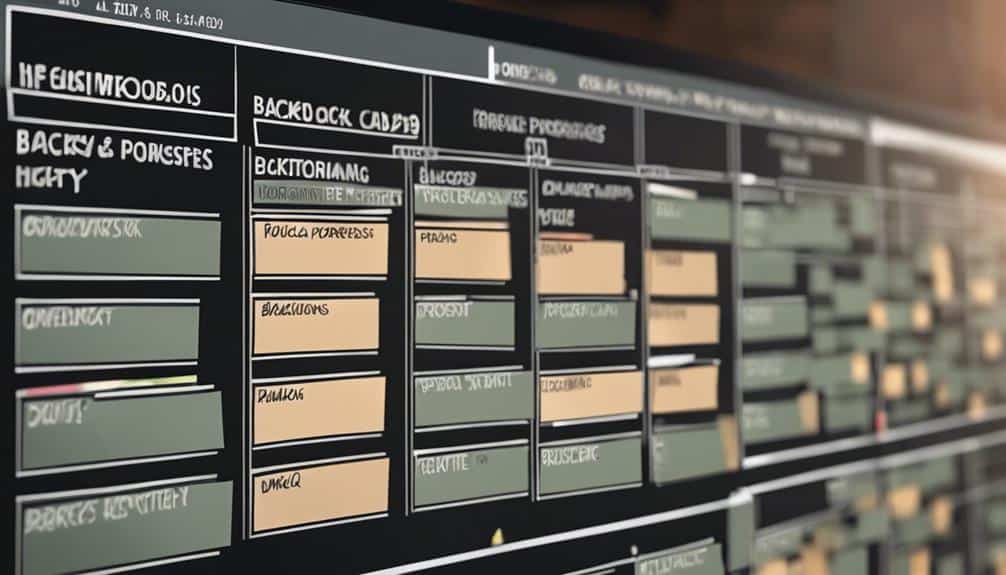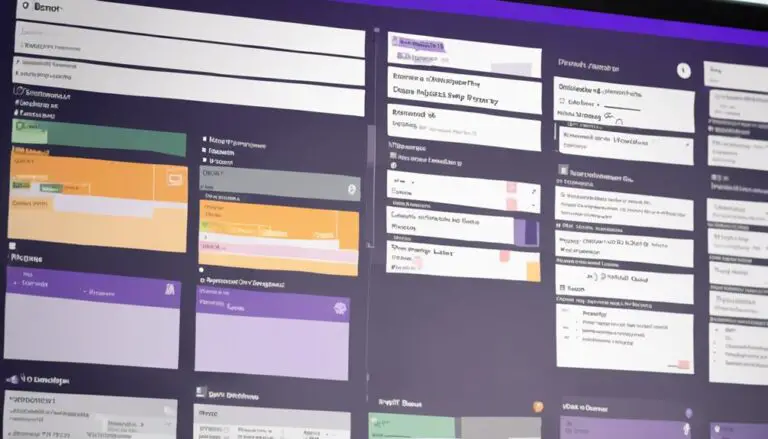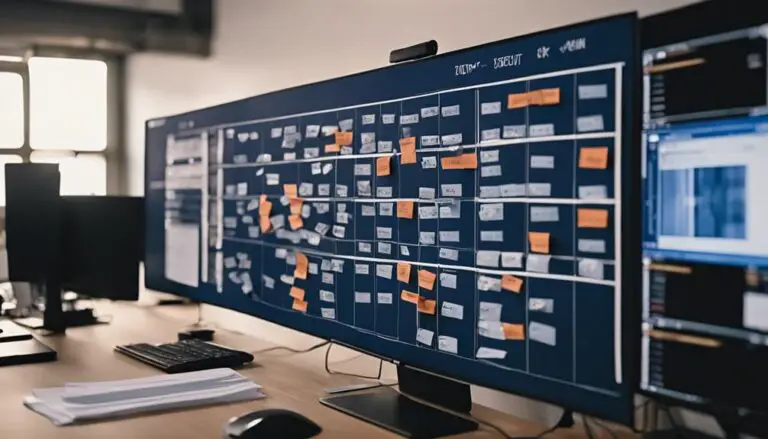In the realm of efficient workflow management, the Kanban backlog acts as the compass guiding your team's journey towards productivity and success.
As you navigate the intricate landscape of task prioritization and workflow optimization, Kanban's utilization of the backlog unveils a methodical approach that streamlines operations and enhances collaboration.
But, how does this system truly revolutionize the way teams operate and achieve their goals?
Key Takeaways
- Kanban Backlog aligns tasks with team capacities for efficient workflow.
- Prioritizing backlog items enhances workflow efficiency and customer satisfaction.
- Regularly updating and refining backlog reflects changing priorities for optimal progress tracking.
- Strategic planning and continuous improvement optimize Kanban Backlog for productivity.
Definition of Kanban Backlog
In Kanban methodology, the backlog acts as a dynamic list of tasks awaiting progression within the workflow. This backlog isn't just a random collection of tasks; it's a carefully curated list that has been prioritized to ensure that the most important work is being addressed first.
By organizing tasks in this manner, teams can effectively manage their workflow, ensuring that valuable work items are completed in a timely fashion. The backlog in Kanban reflects customer value by placing an emphasis on organizing tasks based on their importance and urgency. This approach helps teams stay focused on delivering what matters most to the end-users.
Constantly updating and refining the backlog is essential in Kanban backlog management to align the work with team capacities and ensure a smooth workflow for all involved. By maintaining a prioritized backlog, teams can work collaboratively towards achieving their goals efficiently and effectively.
Backlog Management in Kanban System
When managing your Kanban backlog, prioritizing backlog items and updating the list regularly are crucial for maintaining workflow efficiency.
By prioritizing items based on customer value and setting work-in-progress limits, you can optimize task planning and resource allocation.
Remember to regularly review and refine the backlog to reflect changing priorities and ensure team focus on completing tasks effectively.
Prioritizing Backlog Items
To enhance workflow efficiency in the Kanban system, prioritizing backlog items is crucial for ensuring that the team focuses on high-value tasks and minimizes waste.
By categorizing tasks based on customer value and urgency, the team can streamline its work process and project management.
Classes of service and sequencing policies play a vital role in determining the order in which backlog items are tackled, ensuring that the most critical tasks are addressed promptly.
This prioritization not only leads to increased efficiency and faster delivery but also contributes to improved customer satisfaction.
Updating Backlog Regularly
Regularly updating the backlog in the Kanban system ensures that the team stays focused on prioritizing the most relevant and important tasks for efficient workflow management. By continuously refining and reprioritizing user stories based on changing needs and project requirements, backlog management in Kanban facilitates a clear understanding of work priorities.
Utilizing classes of service and sequencing policies helps define the priority and order of backlog items, enhancing team focus on addressing high-value work promptly. Prioritizing the backlog not only streamlines workflow but also ensures that teams are working on tasks that align with project goals.
Maintaining an organized and up-to-date backlog in Kanban enables teams to track progress effectively and make informed decisions for successful project completion.
Prioritizing Tasks in Kanban Backlog
Prioritizing tasks in the Kanban backlog involves assigning value based on customer needs and business goals to ensure the most valuable work is completed first in the workflow. By utilizing visual representations of work and implementing WIP limits, you can effectively prioritize your tasks in Kanban.
Classes of service and sequencing policies play a crucial role in determining the order in which tasks are tackled, ensuring that high-priority items are addressed promptly. This approach enables teams to focus on high-impact items, leading to increased efficiency and productivity.
Prioritizing tasks in the backlog not only streamlines workflow but also enhances the delivery of valuable outcomes. Embracing effective backlog prioritization practices in Kanban is key to optimizing productivity and achieving successful project outcomes.
Role of Backlog in Workflow Optimization
Backlog management plays a pivotal role in optimizing workflow efficiency and ensuring seamless task progression in Kanban methodology. In Kanban, the backlog serves as a centralized hub for all work items, allowing teams to prioritize tasks based on importance and urgency.
By utilizing virtual Kanban boards, teams can visualize the flow of work in progress, ensuring that tasks move smoothly through the workflow. Kanban cards within the backlog aid in backlog grooming, where tasks are refined, estimated, and prioritized for efficient delivery. This process not only enhances transparency but also enables the team to track progress effectively and address any blockers promptly.
Through continuous improvement facilitated by effective backlog management, teams can enhance collaboration, align work with priorities, and accelerate project delivery, ultimately leading to optimized workflow efficiency in Kanban methodology.
Efficient Task Tracking With Kanban Backlog
When tracking tasks with the Kanban backlog, you can benefit from efficient task prioritization methods. This approach allows for continuous improvement of workflow by ensuring tasks are addressed in the right order.
Clear task visibility offered by the Kanban backlog enhances your team's productivity and collaboration.
Task Prioritization Methods
In Kanban, efficient task tracking with the backlog involves utilizing user stories reflecting customer value to prioritize tasks effectively. By classifying tasks into different classes of service and establishing sequencing policies, you can categorize and order tasks in the Kanban backlog.
Prioritizing tasks within the backlog offers advantages such as enhanced task planning and increased throughput. Regularly updating priorities based on evolving requirements is crucial for maintaining the Kanban backlog.
Efficient Kanban backlog management ensures a smooth workflow progression and timely task completion. By incorporating these prioritization methods, you can streamline your workflow and optimize the delivery of value to your customers, ultimately contributing to the success of your projects.
Continuous Workflow Improvement
To enhance the efficiency of your workflow and track tasks effectively in Kanban, prioritize continuous improvement by leveraging the Backlog for seamless task management.
Here's how you can continuously improve and optimize your workflow using the Kanban Backlog:
- Visualize your work: Utilize the Kanban board to visually represent backlog items and monitor progress effortlessly.
- Prioritize tasks: Ensure high-value tasks are addressed first to enhance overall workflow efficiency.
- Efficient task tracking: Use the Backlog to track tasks efficiently and maintain a steady flow of work.
- Improve workflow efficiency: By leveraging the Kanban Backlog, teams can achieve faster delivery and increased productivity.
- Adapt and refine: Continuously adapt and refine workflow processes for optimal efficiency and effectiveness.
Clear Task Visibility
Enhance your workflow efficiency and task tracking in Kanban by leveraging the clear task visibility provided through the Kanban backlog.
The Kanban backlog organizes work items in a prioritized list, making it easier to track and manage tasks, ensuring a smooth workflow progression.
By visually representing backlog items on the Kanban board, teams can easily monitor task visibility and status. Prioritizing tasks within the backlog allows teams to concentrate on high-value work items first, promoting efficiency.
This structured workflow maintained through the Kanban backlog helps in clearly defining and tracking tasks, fostering a more organized and productive work environment.
Embrace the Kanban backlog to streamline your workflow and enhance task visibility for improved collaboration and task management.
Benefits of Utilizing Backlog in Kanban
Utilizing the backlog in Kanban streamlines task prioritization and enhances team efficiency by providing clear visibility and alignment with customer needs. By incorporating the Kanban methodology into your team's workflow, you can experience a range of benefits:
- Efficient Work Item Management: The backlog enables teams to manage and prioritize work items effectively, ensuring that the most critical tasks are addressed first.
- Transparency and Customer Alignment: Using backlog in Kanban promotes transparency within the team and ensures alignment with customer needs, leading to better outcomes.
- Progress Tracking and Resource Optimization: Backlog aids in tracking progress on tasks, allowing for better resource allocation and improved decision-making.
- Continuous Improvement: Kanban backlog utilization facilitates a culture of continuous improvement, where teams can adapt and optimize their workflows over time.
- Enhanced Workflow Efficiency: By leveraging the Kanban backlog, teams can enhance their workflow efficiency, leading to smoother and more productive operations.
Implementing Kanban Backlog for Productivity
Transitioning smoothly from understanding the benefits of utilizing backlog in Kanban, implementing Kanban backlog for productivity involves strategic planning and structured organization to optimize workflow efficiency and task prioritization. Kanban backlog serves as a repository of user stories that reflect customer value, aiding in the effective prioritization of work items.
By utilizing classes of service and sequencing policies, the backlog can be structured to facilitate optimal workflow management, ensuring that tasks are completed in a timely manner. Prioritizing the backlog in Kanban is crucial as it leads to improved task planning and faster throughput, ultimately enhancing productivity.
Effective backlog management in Kanban is essential for enabling continuous delivery and streamlining work processes. Regular grooming, updating, and refining of the Kanban backlog are necessary to maintain its relevance and optimize workflow efficiency. By embracing these practices, you can harness the power of Kanban backlog to drive productivity and achieve your desired outcomes efficiently. Additionally, it is important to consider team capacity considerations when managing the Kanban backlog. This involves understanding the workload of each team member and prioritizing tasks accordingly to ensure that they are not overwhelmed. By factoring in team capacity considerations, you can ensure that work is distributed evenly and that it aligns with the team’s capabilities, ultimately leading to a more efficient and productive workflow.
Frequently Asked Questions
How Does Kanban Backlog Work?
In Kanban, your backlog organization ensures tasks are visible, refined, and groomed regularly. Prioritization guarantees valuable work is addressed first, optimizing workflow efficiency. Keep the backlog updated for a smooth workflow.
What Is an Effective Workflow for Kanban?
To create an effective workflow for Kanban, focus on continuous improvement. Use visual cues, limit work-in-progress, conduct daily stand-ups, and promote team collaboration. By standardizing processes and swiftly resolving blockers, your team ensures efficiency and success.
How Do I Manage My Backlog in Kanban?
When managing your backlog in Kanban, focus on organization, prioritization, and tracking tasks effectively. By setting clear priorities, you can enhance workflow efficiency and ensure smooth progress through backlog management for optimal results.
How Do I Prioritize Backlog in Kanban Board?
Prioritizing backlog in Kanban board is crucial for workflow optimization. By refining task management through backlog prioritization and continuous improvement, you ensure efficient resource allocation and faster delivery cycles. Regular backlog grooming reflects evolving priorities.
Conclusion
In conclusion, Kanban utilizes the backlog to streamline workflow and boost productivity. By effectively managing tasks, prioritizing work, and tracking progress, the backlog ensures that team efforts are focused and efficient.
Implementing Kanban backlog in your workflow can lead to a dramatic increase in productivity, making it a valuable tool for optimizing your team's performance. So, don't wait any longer – start using Kanban backlog today and watch your efficiency soar to new heights!





